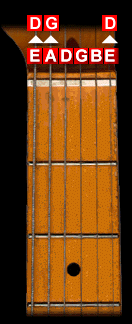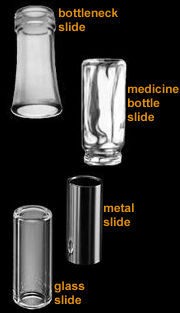Scroll through the lesson and click on notation/video/audio links to load the interactive players.
| Michael Johnson >> Blues Legends III >> |
|
|
Please subscribe to get full access to all lessons for only $7.95/month PLUS 1 week free trial.

Riff Interactive lessons are
LESS expensive and
MORE interactive than alternatives!
More Info
|
|
| Lesson Subject:
Blues Legends III |
| What you learn:
Blind Willie Johnson Style |
| Teacher: Michael Johnson |
Michael: Our lesson tonight continues our study
on acoustic delta blues legends, our feature guitarist is
Blind Willie Johnson. Blind Willie was considered to
be very influential slide blues player, but not as famous
as Robert Johnson. The delta blues players usually detuned to an open tuning to allow
playing slide licks easier. Here's a sample of the slide licks you'll
learn:
Lesson Sample
Michael: Here's a graphic for
tuning to open G:
Open G
tuning

Michael:
Notice you drop the 1st, 5th & 6th
strings each one whole-step. Here's an audio clip of how your guitar should
sound strumming on the open strings:
open G sound clip
Michael: G major
has: G. A. B. C. D. E.
F#
the major chord = G (I), B (III), D
(V)
Michael:
You can use different slides as well, I
use a glass slide myself:
Slides

DFE: Is the thickness of the glass
important?
Michael:
The thicker glass slides sound
better to me, here's some images of proper slide
techniques.
Slide
Positions/Techniques

ginger: Do
you use a heavier set of strings?
Michael:
Yes I do Ginger, heavy
strings help and have better tone. Higher action on your guitar also
helps.
Michael: Notice you get proper intonation by
playing directly over the fret. Make sure you don't hold the slide pressing on
the fretboard and fret, glide firmly on the strings. Also use your back
fingers to mute the strings a little to get a better tone and avoid string
buzzing. Here's our rhythm progression, to play a rhythm in an open tuning you'll
have to adjust the progression a bit.
Michael: Since the A
string is detuned, all you have to do is barre or play the 4th and 5th strings
to play a 5 chord. It's actually easier to play this progression. Here's the jam
track:
Looping Jam
Track
Michael:
This is a common, I, IV, V, blues progression. At the end of the phrase you can
add a turnaround to end and begin the progression.
ginger: Is it more advantageous to wear the slide on
your pinky than your ring finger?
Michael:
Excellent question! If you use the
slide on the 4th finger, you have the ability to play licks and chords with the
other 3 fingers, but for some using the 3rd finger seems more comfortable.
Here's a few turnarounds variations you can use:
Michael:
This first turnaround you can play the 5th string open and then use the
descending line on the 4th string and open 3rd string. You can pick both strings
at the same time or you can pick between the middle two strings, like in this
next turnaround lick:
Michael:
You can also include the 2nd string as
well:
Michael:
Anybody
without a slide you can use a glass bottle, drinking glass or medicine bottle.
Here's our first slide guitar lick:
Slide
Lick 2
Michael:
This plays in the same basic positions, but uses double
strings. This slide lick is also pretty easy, just slide up to the 12th fret on the 1st and
2nd strings, then shift to sliding to the 3rd fret. It's really not that
hard to play slide licks once you get use to using a slide. Try playing the lick
over the jam track. Here's another slide lick:
Slide Lick
2
DFE: Do
you have to slide until the fret is in the middle of the
slide?
Michael:
Yes, you slide to the top off the
fret. Now when the progression changes, you can follow with changing the
slide positions that relate to the chord positions. In this next example you
shift playing to the IV (C) of the progression change:
Slide Lick
3
Michael: Now you can
follow playing over the V (D) of the progression and move to the IV (C) and back
to the I (G). All in a series of connected licks.
Slide Lick
4
Michael:
Then you can add on one of the turnarounds to end the progressions, like one of
the ones you learned earlier:
Turnaround 2
Michael:
This brings
it all back home, much in the way the lesson sample comes
together that I gave you earlier in the lesson.
Michael:
Any questions before I go? I hope you all have fun with this
lesson.
DFE: To
change the Key do you have to tune
another? I mean to play in a another key.
Michael:
Good question, you can play different positions to
change the key, or you can change to a different tuning. Here's the basic
positions we were using for G I, IV, V:
Michael: Here's the
A - I, IV, V positions.
Michael:
And so forth, see how the positions change with the key, but in this tuning G
sounds the best because of the open string notes you can use for most of these
licks.
DFE: yes,
thanks... merci
Michael: Well, time
to go, see you next lesson!
|
<< load notation from left
|
|
<< load audio from left
|
<< load audio from left
|